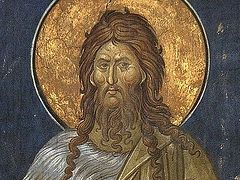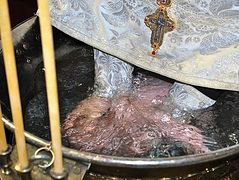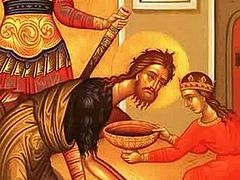The Synaxis of St. John the Forerunner and Baptist of the Lord is an Orthodox feast day established in honor of this saint. The Church has a custom of glorifying those righteous servants of God who most closely served in a celebrated event on the day following certain great feast days.
On the next day after Holy Theophany, or the Baptism of the Lord, we celebrate the Synaxis of the Forerunner and Baptist John, who served the sacrament of Divine Baptism by laying his hand on the head of the Savior. As for the word “synaxis” in the name of the feast, St. Dimitry of Rostov noted that it “means that the people gather in the church for services that honor and praise the great Forerunner and Baptist John, whom we glorify on this day."
The greatest of the prophets, St. John the Baptist, concludes the Old Testament history and heralds the era of the New Testament. The son of the priest Zechariah and righteous Elizabeth, he was a relative of the Lord through his mother. Prophet John was born six months before the birth of Christ. His parents, who reached old age without children, continued to fervently pray, and the Lord heard them. Archangel Gabriel announced that they would soon have a son, and that he should be named John.
There is no information about St. John’s childhood and youth. When King Herod learned of the birth of Jesus Christ, he ordered the killing of all infants in Bethlehem who were two years old and younger, based on the information he received from the Magi. Righteous Elizabeth managed to hide with her son in the wilderness, while his father, at the time, was questioned concerning his son while serving in the temple. When he refused to answer, he was killed right in the sanctuary.
John grew up in the wilderness, preparing himself for his prophetic ministry through strict fasting, contemplation, and prayer. At around the age of thirty, he began preaching repentance. St. John the Baptist appeared on the banks of the Jordan River to prepare people for the coming of the Savior of the world. Jerusalem, all Judea, and the whole region around the Jordan went out to him (Matt. 3:5). Many were baptized by him, including the Lord Jesus Christ Himself. St. John the Baptist had the honor of baptizing Him in the waters of the Jordan and witnessing the mysterious manifestation of the Holy Trinity on the day of the Savior’s Baptism.
After that, John the Baptist continued his preaching, exposing the sins and vices of his contemporaries and calling them to repentance. He testified to the coming of the Only-Begotten Son of God, who took on human flesh.
The earthly life of the holy prophet John ended in martyrdom. Because he condemned Herod Antipas, who had left his lawful wife to live with Herodias, the wife of his brother Philip, the Baptist was thrown into prison and beheaded.
The holy relics of St. John the Baptist were buried by his disciples in the Samaritan city of Sebaste. In 362 AD, by the order of Emperor Julian the Apostate, the holy relics of John the Baptist were burned along with the Church of Sebaste. However, his head, right hand, and particles of his relics were preserved.
One of the most revered relics in the Christian world, the right hand of St. John the Baptist, which he placed on the head of Jesus Christ during the Baptism, was transferred to Russia by the Maltese Order in 1799. The relic was initially placed in the Gatchina Court Church, then moved to St. Petersburg, to the grand cathedral of the Winter Palace. In 1919, due to danger from Bolsheviks, it was transported to Revel (Tallinn), and later, through Sweden, to Denmark. Eventually, the relic became the possession of the Serbian royal family of Karadjordjevic, given to King Alexander in gratitude for Serbia providing refuge to many Russian emigrants. Through divine providence, and thanks to the efforts of clergy and devout laity, the great relic was saved during the German occupation. After the war, it was taken by Yugoslav special services to the city of Titograd (Podgorica). For many years, the right hand was considered lost forever. Since January 20 (the day of the feast of the Synaxis of St. John the Baptist) of 1978, the venerable relic has been in the Monastery of the Mother of God in the city of Cetinje.




